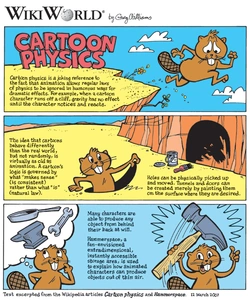
This picture shows the applicability of distinct "toon physics" effects in favor of cartoon characters.
Toon physics are rules of how the universe works in cartoons. While most of the characters in the Scooby-Doo universe are relatively realistic, others have a higher degree of "tooniness" which gives them what amounts to super-powers.
Scooby-Doo possesses this ability to a high degree, and so do other talking canines related to him; Shaggy Rogers has a slightly lesser power; the rest of the gang has only mild tooniness (they had more of it in their childhood).
Rules of toon physics[]
- Gravity has no effect on a character unless they look down and become aware they should fall.
- Fear cancels gravity. A scared character can leap to arbitrary heights.
- Rebounds increase momentum. Velma had this ability in A Pup Named Scooby-Doo.
- A running character can crash through any wall, leaving a hole in the wall conforming to their outline.
- Painting black holes and entrances in floors and/or walls allow (mostly) protagonists to actually walk through or drop down into said walls and holes completely unharmed - sometimes, the effect will "switch off" so that other character(s), namely villains or antagonists, will bump into the aforementioned floor/wall and hurt themselves so they'll be unable to keep chasing the protagonist.
- Characters can contort and fit into any container (neither Fred, Daphne or Velma have this ability, but Shaggy had shown to have it to a limited degree in A Pup Named Scooby-Doo).
- Inflating someone with air can make them balloon out and become lighter than air.
- Releasing the pressure on someone or something filled with air converts the character/object into a jet-propelled rocket whose extremely erratic flight inevitably lands on the villain or does something funny.
- Characters can produce arbitrary objects from thin air, or "hammerspace". A version of this rule was in A Pup Named Scooby-Doo, where Velma could fit anything (mostly her computer) in her bag, and Sugie had a bottomless (but heavy) baby bag. Another recurring example was present in The 13 Ghosts of Scooby-Doo, in which Flim-Flam could store enormous objects inside the minuscule pockets of his yellow tracksuit.
- Creating a situation with disguises will fool even the smartest villain, at least for a short time.
- The Scooby-Dooby doors effect allows character being chased from one room to another, or who are being looked for in a set of containers, to automatically appear in different rooms or containers regardless of how they got there.
- When a character is scared, their necks pop forward, their eyes pop out of their heads and their hair stands on end or falls off. This happened a lot in A Pup Named Scooby-Doo, where all the gang could do this, as it was in a style similar to Bob Clampett's.
- Some dogs can talk, walk on two legs in a pinch, and eat human food, while still being very doggish.
- Shaggy sometimes demonstrates knowledge of Scooby's powers and treats him a bit like a genius. For example, when they were being chased by Vikings in a hand-car and needed a way to escape, Shaggy asked Scooby to "think of something" that would help. Scooby produced a flying bicycle from hammerspace that they used to fly away.
- Characters are generally invulnerable to serious harm no matter what happens to them. This was highlighted in Scoobynatural when, due to the nature of the crossover between the Supernatural and Scooby-Doo, Where Are You! world's physics, Fred suffers a bloody nose and Shaggy a broken arm due to falling a great height. When he breaks his arm, Shaggy points out other instances where he has suffered a similar fall and was completely unhurt, including falling from a biplane. After fooling the Mystery Inc. gang to keep their peace of mind, Castiel discreetly uses his angelic powers to heal Shaggy's arm so Shaggy believes he was wrong about the injury and is thus left none the wiser.
